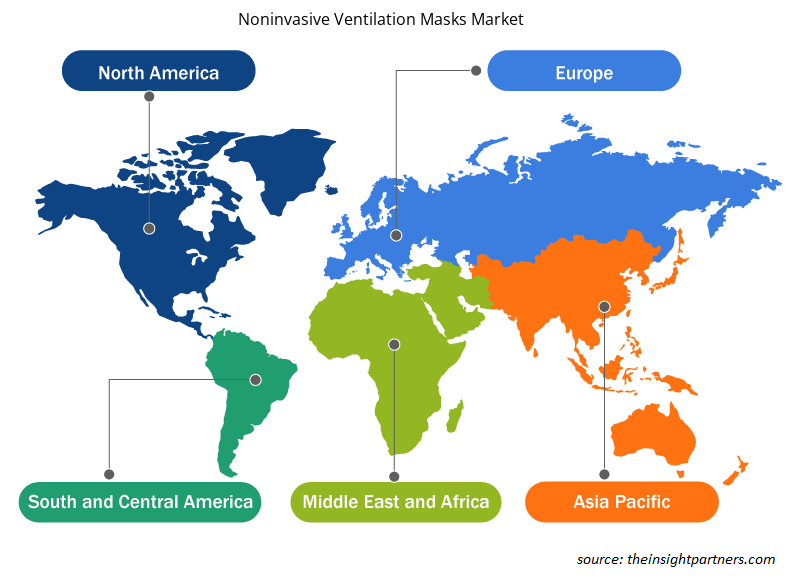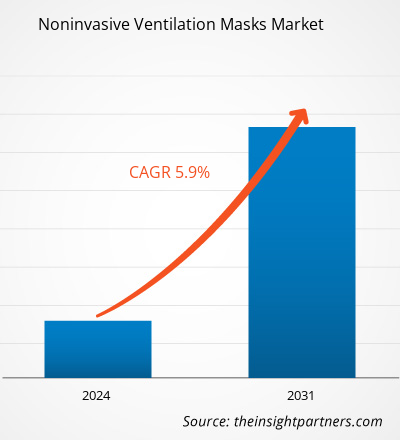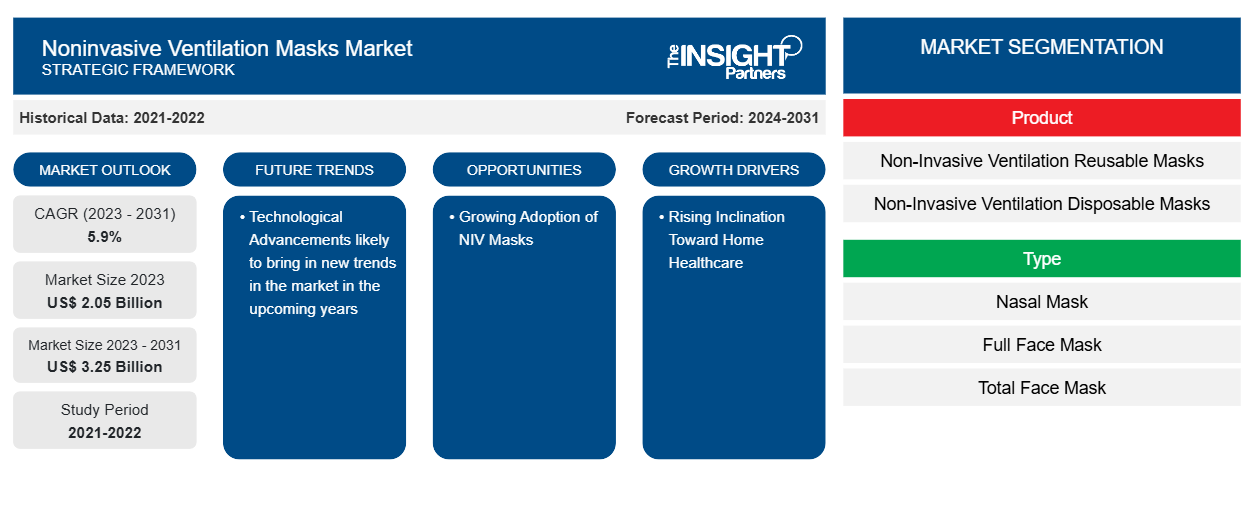Se proyecta que el tamaño del mercado de máscaras de ventilación no invasiva alcance los 3250 millones de dólares estadounidenses en 2031, frente a los 2050 millones de dólares estadounidenses en 2023. Se espera que el mercado registre una CAGR del 5,9 % durante el período 2023-2031. Es probable que los crecientes avances tecnológicos en las máscaras de ventilación no invasiva actúen como una tendencia futura en el mercado en los próximos años.
Análisis del mercado de mascarillas de ventilación no invasiva
Los métodos de ventilación invasiva suelen evitarse en pacientes con EPOC para reducir los riesgos de complicaciones como infecciones y lesiones pulmonares mecánicas. Se prefieren las mascarillas de ventilación no invasiva porque proporcionan asistencia respiratoria sin necesidad de intubación . Por tanto, la naturaleza crónica y a largo plazo de la EPOC y la apnea del sueño conduce a compras repetidas y crea una demanda de mascarillas de ventilación no invasiva , lo que genera un mercado estable y sostenible para los fabricantes.
Descripción general del mercado de máscaras de ventilación no invasiva
Según las estimaciones del Consejo Nacional sobre el Envejecimiento, Inc., 39 millones de adultos en los EE. UU. tenían AOS en 2023. Según un artículo titulado "¿Qué sabe una población suiza frágil sobre la enfermedad pulmonar obstructiva crónica?", alrededor de 400.000 personas en Suiza sufrieron EPOC en 2021. La ventilación no invasiva ( VNI ) es la administración de soporte de oxígeno a través de una mascarilla facial, eliminando la necesidad de una vía aérea endotraqueal en el tratamiento de diversas afecciones, incluida la EPOC , el edema pulmonar cardiogénico y otras afecciones respiratorias sin complicaciones como debilidad de los músculos respiratorios, traumatismo de las vías respiratorias superiores y neumonía asociada al respirador. Las máscaras de ventilación no invasiva pueden ser reutilizables o desechables. Las máscaras de ventilación no invasiva desechables son de un solo uso y se desechan para reducir el riesgo de contaminación cruzada. Los avances en el diseño de máscaras, la comodidad, la durabilidad y la incorporación de materiales respetuosos con la piel pueden impulsar la adopción de máscaras de VNI a medida que los pacientes buscan productos más eficientes y cómodos. Por lo tanto, se espera que la adopción de máscaras NIV como un tratamiento eficaz de estas afecciones respiratorias prevalentes continúe impulsando el crecimiento del mercado de máscaras de ventilación no invasiva durante 2023-2031.
Personalice este informe según sus necesidades
Obtendrá personalización en cualquier informe, sin cargo, incluidas partes de este informe o análisis a nivel de país, paquete de datos de Excel, así como también grandes ofertas y descuentos para empresas emergentes y universidades.
- Obtenga las principales tendencias clave del mercado de este informe.Esta muestra GRATUITA incluirá análisis de datos, desde tendencias del mercado hasta estimaciones y pronósticos.
Impulsores y oportunidades del mercado de las mascarillas de ventilación no invasiva
La creciente inclinación hacia la atención médica domiciliaria impulsa el mercado
El cambio de los centros de atención a largo plazo, la rehabilitación para pacientes internados y los centros de enfermería especializada a los entornos de atención domiciliaria da como resultado una interacción mejor, consistente y oportuna entre el paciente y el médico gracias a la nube y a los dispositivos médicos impulsados por la movilidad . El brote de COVID-19 puso de relieve la importancia de la atención médica domiciliaria debido a la capacidad limitada de camas hospitalarias y a la escasez de profesionales sanitarios cualificados. Con la ayuda de la atención médica domiciliaria, los profesionales sanitarios pueden controlar los signos vitales del paciente de forma remota y evitar las admisiones hospitalarias.
Además, los pacientes con enfermedades como EPOC , apnea del sueño y otros problemas respiratorios expresan cada vez más su preferencia por el tratamiento domiciliario de sus dolencias. Los pacientes pueden utilizar la terapia VNI en la comodidad de sus hogares sin tener que hacer visitas frecuentes al hospital. Los proveedores de atención médica domiciliaria prescriben mascarillas VNI con mayor frecuencia como un componente de los planes integrales de atención respiratoria.
Por lo tanto, debido a la creciente tendencia hacia la atención médica domiciliaria y la creciente demanda de dispositivos más avanzados, asequibles y de fácil uso en el hogar, el mercado de máscaras de ventilación no invasiva está ganando terreno notable.
La creciente adopción de mascarillas NIV ofrece oportunidades de mercado
Las mascarillas de ventilación no invasiva son cada vez más populares y amplían las oportunidades de mercado al estimular la innovación. El diagnóstico y el tratamiento tempranos son posibles gracias a las crecientes campañas de concienciación sobre trastornos respiratorios como la EPOC , la apnea del sueño y otros. El aumento de la prescripción y el uso de mascarillas NIV para el tratamiento de enfermedades es resultado de una mayor concienciación entre los pacientes y los profesionales sanitarios. Por lo tanto, es probable que la creciente conciencia del diagnóstico temprano impulse la adopción de mascarillas NIV y cree oportunidades significativas en el mercado. Además, las enfermedades respiratorias son cada vez más comunes en las economías emergentes, particularmente en Asia Pacífico, América Latina y Oriente Medio, debido a la contaminación, la urbanización y los cambios en el estilo de vida. Las terapias no invasivas se están volviendo ampliamente conocidas en estas áreas, por lo que es probable que el uso de mascarillas NIV continúe impulsándose durante el período de pronóstico.
Análisis de segmentación del informe de mercado de máscaras de ventilación no invasiva
Los segmentos clave que contribuyeron a la derivación del análisis del mercado de máscaras de ventilación no invasiva son el producto, la aplicación y el usuario final.
- Según el producto, el mercado de mascarillas de ventilación no invasiva se divide en mascarillas desechables de ventilación no invasiva y mascarillas reutilizables de ventilación no invasiva. El segmento de mascarillas desechables de ventilación no invasiva tuvo una mayor participación en el mercado de mascarillas de ventilación no invasiva en 2023.
- Según la aplicación, el mercado se segmenta en apnea obstructiva del sueño, enfermedad pulmonar obstructiva crónica, neumonía y otras. El segmento de apnea del sueño tuvo la mayor participación en el mercado de máscaras de ventilación no invasiva en 2023.
- Según el usuario final, el mercado está segmentado en hospitales y clínicas, atención domiciliaria y otros. El segmento de hospitales y clínicas tuvo la mayor participación del mercado de mascarillas de ventilación no invasiva en 2023.
Análisis de la cuota de mercado de las mascarillas de ventilación no invasiva por geografía
El alcance geográfico del informe de mercado de mascarillas de ventilación no invasiva se divide principalmente en cinco regiones: América del Norte, Asia Pacífico, Europa, América del Sur y Central, y Oriente Medio y África. América del Norte dominó el mercado en 2023. Estados Unidos es el mercado más grande y de más rápido crecimiento para las mascarillas de ventilación no invasiva. Según la Asociación Médica Estadounidense, ~30 millones de personas en los EE. UU. Tenían apnea del sueño en 2022; sin embargo, solo 6 millones fueron examinados para esta condición. Además, ~14,8 millones de adultos han sido diagnosticados con EPOC en el mismo año, que es la cuarta causa principal de muerte en los EE. UU. Se espera que la creciente prevalencia de estas enfermedades pulmonares crónicas aumente la demanda de opciones de tratamiento NIV, impulsando el crecimiento del mercado de mascarillas de ventilación no invasiva en los EE. UU.
Además, se espera que la presencia de actores líderes del mercado, como Sleepnet Corporation, Philips y Hamilton Medical, que ofrecen máscaras NIV y los desarrollos estratégicos de estos actores del mercado en los EE. UU. aumenten la participación de mercado de máscaras de ventilación no invasiva en el país durante el período de pronóstico. Por ejemplo, en agosto de 2024, Sleepnet Corporation se asoció con un reconocido hospital pediátrico estadounidense para presentar la máscara Mini Me 2 NIV para estudiar el impacto de los dispositivos médicos innovadores en la atención al paciente.Sleepnet Corporation, Philips, and Hamilton Medical, offering NIV masks and strategic developments by these market players in the US are expected to increase the noninvasive ventilation masks market share in the country during the forecast period. For instance, in August 2024, Sleepnet Corporation partnered with a renowned US pediatric hospital to introduce the Mini Me 2 NIV mask for studying the impact of innovative medical devices on patient care.
Perspectivas regionales del mercado de mascarillas de ventilación no invasiva
Los analistas de Insight Partners han explicado detalladamente las tendencias y los factores regionales que influyen en el mercado de mascarillas de ventilación no invasiva durante el período de pronóstico. Esta sección también analiza los segmentos y la geografía del mercado de mascarillas de ventilación no invasiva en América del Norte, Europa, Asia Pacífico, Oriente Medio y África, y América del Sur y Central.

- Obtenga datos regionales específicos para el mercado de máscaras de ventilación no invasiva
Alcance del informe de mercado de mascarillas de ventilación no invasiva
| Atributo del informe | Detalles |
|---|---|
| Tamaño del mercado en 2023 | US$ 2.050 millones |
| Tamaño del mercado en 2031 | US$ 3.25 mil millones |
| CAGR global (2023 - 2031) | 5,9% |
| Datos históricos | 2021-2022 |
| Período de pronóstico | 2024-2031 |
| Segmentos cubiertos | Por producto
|
| Regiones y países cubiertos | América del norte
|
| Líderes del mercado y perfiles de empresas clave |
|
Densidad de actores del mercado de mascarillas de ventilación no invasiva: comprensión de su impacto en la dinámica empresarial
El mercado de mascarillas de ventilación no invasiva está creciendo rápidamente, impulsado por la creciente demanda de los usuarios finales debido a factores como la evolución de las preferencias de los consumidores, los avances tecnológicos y una mayor conciencia de los beneficios del producto. A medida que aumenta la demanda, las empresas amplían sus ofertas, innovan para satisfacer las necesidades de los consumidores y aprovechan las tendencias emergentes, lo que impulsa aún más el crecimiento del mercado.
La densidad de actores del mercado se refiere a la distribución de las empresas o firmas que operan dentro de un mercado o industria en particular. Indica cuántos competidores (actores del mercado) están presentes en un espacio de mercado determinado en relación con su tamaño o valor total de mercado.
Las principales empresas que operan en el mercado de máscaras de ventilación no invasiva son:
- Hamilton Medical AG,
- ResMed Inc.,
- Fisher & Paykel Healthcare Corp. Ltd.,
- Sistemas médicos Air Liquide,
- Dragerwerk AG & Co KGaA,
Descargo de responsabilidad : Las empresas enumeradas anteriormente no están clasificadas en ningún orden particular.

- Obtenga una descripción general de los principales actores clave del mercado de máscaras de ventilación no invasiva
Noticias y desarrollos recientes del mercado de mascarillas de ventilación no invasiva
El mercado de las mascarillas de ventilación no invasiva se evalúa mediante la recopilación de datos cualitativos y cuantitativos a partir de una investigación primaria y secundaria, que incluye importantes publicaciones corporativas, datos de asociaciones y bases de datos. A continuación, se enumeran algunos de los avances del mercado:
- SunMed adquirió el negocio de consumibles respiratorios y de anestesia de Vyaire Medical. Esta adquisición combinó las fortalezas de ambas empresas para mejorar la innovación, garantizar un suministro confiable de productos y brindar productos médicos de alta calidad para obtener mejores resultados para los pacientes. [Fuente: SunMed Group Holdings LLC (AirLife), sitio web de la empresa, marzo de 2023].
- Intersurgical adquirió Pulmodyne, un fabricante con sede en EE. UU. y Malasia especializado en productos respiratorios y para las vías respiratorias. La adquisición ampliará la gama de productos de Intersurgical, fortalecerá su presencia en el mercado estadounidense y aumentará las ventas de productos Pulmodyne a nivel mundial. (Fuente: ICU Medical, sitio web de la empresa, enero de 2022)
Informe de mercado sobre mascarillas de ventilación no invasiva: cobertura y resultados
El informe "Tamaño y pronóstico del mercado de máscaras de ventilación no invasiva (2021-2031)" proporciona un análisis detallado del mercado que cubre las siguientes áreas:
- Tamaño del mercado de máscaras de ventilación no invasiva y pronóstico a nivel mundial, regional y nacional para todos los segmentos clave del mercado cubiertos bajo el alcance
- Tendencias del mercado de máscaras de ventilación no invasiva, así como dinámica del mercado, como impulsores, restricciones y oportunidades clave
- Análisis PEST y FODA detallados
- Análisis del mercado de máscaras de ventilación no invasiva que cubre las tendencias clave del mercado, el marco global y regional, los principales actores, las regulaciones y los desarrollos recientes del mercado
- Análisis del panorama de la industria y de la competencia que abarca la concentración del mercado, el análisis de mapas de calor, los actores destacados y los desarrollos recientes del mercado de máscaras de ventilación no invasiva
- Perfiles detallados de empresas
- Análisis histórico (2 años), año base, pronóstico (7 años) con CAGR
- Análisis PEST y FODA
- Tamaño del mercado, valor/volumen: global, regional y nacional
- Industria y panorama competitivo
- Conjunto de datos de Excel
Informes recientes
Testimonios
Razón para comprar
- Toma de decisiones informada
- Comprensión de la dinámica del mercado
- Análisis competitivo
- Información sobre clientes
- Pronósticos del mercado
- Mitigación de riesgos
- Planificación estratégica
- Justificación de la inversión
- Identificación de mercados emergentes
- Mejora de las estrategias de marketing
- Impulso de la eficiencia operativa
- Alineación con las tendencias regulatorias























 Obtenga una muestra gratuita para - Mercado de mascarillas de ventilación no invasiva
Obtenga una muestra gratuita para - Mercado de mascarillas de ventilación no invasiva